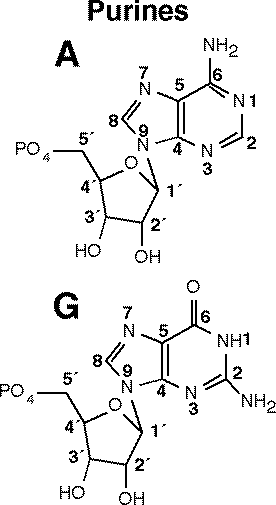|
Background Workflow |
Site /
SubstitutionsAndModificationsIn this step you will begin with the initial subsystem PDB file listed at the bottom of the page and make all necessary substitutions/modifications before bringing it through tLEaP. It is important to begin with this PDB at the beginning of each experimental construct rather than making successive modifications to reduce compounding errors and idiosyncrasies. PDB Columns, referenced below
1 2 3 4 5 6 7 8 9 10 11
ATOM 265 HO5' U 3 172.950 259.409 225.896 1.00 0.00 H
Nucleotide Substitutions t-LEaP has the ability to grow in missing atoms when provided with a residue identity based on standard geometries within its library. In order to preserve the original orientation of the nucleotide when the substitution takes place, as many common atoms as possible should be conserved. Practically speaking, this requires going in and changing the subsystem .pdb. The file to use is linked at the bottom of the page. The first step is to identify the residue(s) you will be changing. You can look up the residue number (PDB Column 5, above) using the following table:
For the nucleotide to be substituted/the residue number(s) you just identified, you will make the following changes: Atoms of the sugar-phosphate backbone (P, OP1, OP2, and any atom with a terminal ' in PDB Column 3, above) should be retained. Non-common atoms of the base only (AKA atoms of the base that do not appear in the Common Atoms table below) should be deleted. For all remaining nucleotide atoms, the column that contains the residue identifier (PDB Column 4, above) for the residue to be substituted needs to be changed (to A, U, G, C, or INO). Lines that contain common atoms of the base should be updated with the correct atom identity (PDB Column 3, above) using the Common Atoms table below. If the atom changes element (i.e. from a C to an O), the last column (PDB Column 11, above) will also need to be modified. Note that for inosine (INO in the table below) you should delete ANY hydrogen atoms in the residue being modified and the OP1 and OP2 atoms. Common Atoms
  Modifications The first step is to identify the residue(s) you will be modifying. You can look up the residue number (PDB Column 5, above) using the following table:
rRNA modifications have been added to the Amber standard library in the leaprc.modrna08 file (see tLEaP page). However, some of the atoms do not follow the same naming convention as the PDB files we have been using. First, you should delete ANY hydrogen atoms in the residue being modified. For the sugar-phosphate backbone, you should delete the OP1 and OP2 atoms. For the base, you will need to bring the structure through tLEaP to make note of the naming convention. First, save a copy of the PDB you have at this stage. Then delete all the base atoms (anything NOT P, OP1, OP2, or any atom with a terminal '), change the column 4 residue identity to the correct three letter code (found in Table 3 of the 2007 Santalucia force field publication), and bring through tLEaP. Look at the modified residue of the resulting PDB for the modified base naming convention. Compare to the PDB copy you saved before you deleted any base atoms. Update the atom identities (column 3, last column) of the base from the copy to match the new PDB you generated, deleting any non-common atoms of the base if there are any. This will allow us to retain the original Cryo-EM residue geometry as much as possible. Post-translationally modified amino acids may also need to be grown in and parameterized but are not a part of Amber's standard library. If the changed residue does not have a force field modification published by a separate group (check here, and here), it will have to be parameterized using antechamber. Antechamber Often drug design involves novel molecules that have never been computationally modeled. For residues that have not been parameterized, the antechamber module of Amber analyzes the molecule and creates a force field modification from the Generalized Amber Force Field (GAFF). If GAFF is unable to generate the force field modification, you will have to parameterize the residue yourself using quantum mechanical calculations (see the Amber manual). This then allows tLEaP to assign parameters to the residue. Paths to Files
5JUP_N2 Starting Structure (unmodified):
/home66/kscopino/SUBSYSTEM_DESIGN/5JUP_N2_GCU.pdb
and /ribosome/Molecular Dynamics/Tutorials and Starting Structures/5JUP_N2_GCU.pdb
/home66/kscopino/SUBSYSTEM_DESIGN/5JUP_N2_CGU.pdb
and /ribosome/Molecular Dynamics/Tutorials and Starting Structures/5JUP_N2_CGU.pdb
Tutorials (on Google Drive):
/ribosome/Molecular Dynamics/Tutorials and Starting Structures/Part1_tLEaP.mp4
WITH CORRECTION:
/ribosome/Molecular Dynamics/Tutorials and Starting Structures/Part1_tLEaP_correction.mp4
|